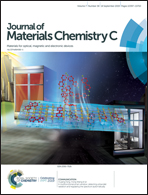Bulk charge-transfer doping of amorphous metal oxide: fullerene blends for solution-processed amorphous indium zinc oxide thin-film transistors†
Abstract
The successful implementation of amorphous In–Ga–Zn–O with a mobility >10 cm2 V−1 s−1 in the electronic industry indicates the significant potential of the amorphous oxide semiconductor (AOS) materials in the next-generation optoelectronics. However, the low-cost, large-area solution processes for AOS materials require high annealing temperatures (>400 °C), which is not favorable for flexible substrate application. Moreover, the lack of a doping method for AOS materials possessing an amorphous disorder structure further limits its application. In this study, a fullerene derivative (C60-malonic acid) was employed as the bulk charge-transfer dopant in solution-processed amorphous indium-zinc oxide (a-IZO) thin-film transistors. With the facile bulk charge-transfer doping from a mixed precursor solution, high-performance thin-film transistors were realized at a low annealing temperature of 250 °C. At an optimized doping concentration, the carrier mobility increased from 1.21 cm2 V−1 s−1 for an undoped a-IZO film to 2.42 cm2 V−1 s−1 for a doped a-IZO one. Furthermore, optimized doping enhanced the device stability under the bias stress condition. Therefore, the threshold voltage (Vth) shift during the positive bias stress condition (VG = 50 V; VDS = 25 V) for 1000 s drastically reduced from 28.9 V for an undoped device to 16.0 V for a device with optimized doping (1%).



 Please wait while we load your content...
Please wait while we load your content...